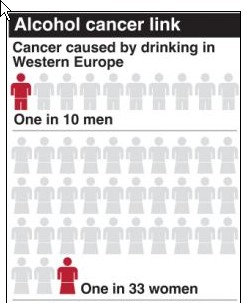Time to cut down on the booze?
As of the 23rd May 2022 this website is archived and will receive no further updates.
understandinguncertainty.org was produced by the Winton programme for the public understanding of risk based in the Statistical Laboratory in the University of Cambridge. The aim was to help improve the way that uncertainty and risk are discussed in society, and show how probability and statistics can be both useful and entertaining.
Many of the animations were produced using Flash and will no longer work.
The recent study on alcohol and cancer published in the British Medical Journal is a fine piece of epidemiology and attracted a lot of coverage of the estimate that 10% of male cancers and 3% of female cancers could be attributed to alcohol. But while it is useful as a description of what happens in populations, as usual when translated to an individual it stops looking so impressive.
According to Cancer Research UK, 1 in 3 of us will get cancer in our lives. So out of 100 average drinkers, 33 will get cancer at some point.
According to Table 2 in the BMJ paper, each 12g drink (1.5 units) increases annual cancer risk by 3%. So if another set of 100 people all had a drink less a day, then we would expect 32 would get cancer. If another set of 100 all drank an extra drink a day, 34 would get cancer.
This reinforces Sir Ian Gilmour's comments that we can't expect such evidence to change people's habits - he says we need to have tougher regulation.
Also the attached graphic in the Daily Mail is dreadful - it strongly suggests that 1 in 10 men will get cancer because of drinking.

Caption
- david's blog
- Log in to post comments

Comments
Anonymous (not verified)
Wed, 13/04/2011 - 6:34pm
Permalink
Time to cut down on the booze?
Anonymous (not verified)
Thu, 14/04/2011 - 1:02pm
Permalink
I was slightly disturbed by
Anonymous (not verified)
Fri, 15/04/2011 - 6:01am
Permalink
Tougher regulation